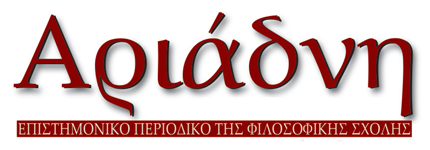Αϊβαλιώτικες μορφές: λαϊκές αγιογραφίες του Κόντογλου, πριν τον καταραμένο διωχμό
DOI:
https://doi.org/10.26248/ariadne.v29i.1794Περίληψη
Kontoglou offers in his works literary descriptions of views of his native city, Aivali, in Asia Minor, definitively lost for him after the cruel persecution that followed the tragic events of 1922. He also delivers a number of literary renditions of representative figures of its habitants. These written depictions, beyond the superficial allure of art naïf that they reflect at first sight, reveal a deep philosophical, aesthetic and emotional view of Kontoglou’s country and compatriots, of his beloved Orient. Through these portraits which are aligned with the art of rhetorical byzantine descriptions known as Ekphrasis, Kontoglou describes in a very personal and emotional way, his countrymen in order to present them to his readers as sanctified figures of his own mystic sacred paradise; the saints he created converge by their various characteristics, both corporeal and moral, to one original identity: the Homo Orientis.
Λήψεις
Δημοσίευση
Πώς να δημιουργήσετε Αναφορές
Τεύχος
Ενότητα
Άδεια

Αυτή η εργασία είναι αδειοδοτημένη υπό το CC Αναφορά Δημιουργού – Μη Εμπορική Χρήση – Παρόμοια Διανομή 4.0.
Οι εργασίες που δημοσιεύονται στο περιοδικό μπορούν να χρησιμοποιηθούν ελεύθερα για μη-εμπορικούς σκοπούς με την προϋπόθεση ότι γίνεται αναφορά στους συγγραφείς και την πρώτη δημοσίευση. Στην περίπτωση που το άρθρο αλλοιωθεί, τροποποιηθεί ή δημιουργηθεί κάτι νέο βασισμένο στο αρχικό, το έργο που θα προκύψει θα μπορεί να διανεμηθεί μόνο με την ίδια ή παρόμοια άδεια (Creative Commons Attribution-NonCommercial-ShareAlike 4.0 International License).


